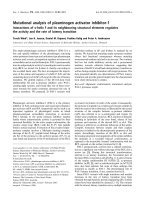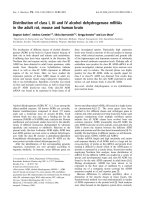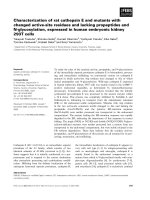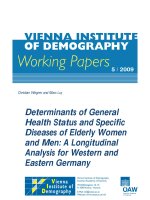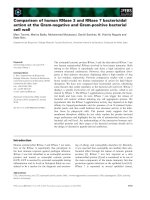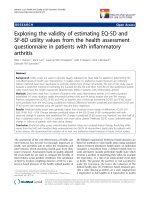Determinants of undergraduate academic achivement and satisfaction with online learning during the covid 19 pandemic
Bạn đang xem bản rút gọn của tài liệu. Xem và tải ngay bản đầy đủ của tài liệu tại đây (1.06 MB, 95 trang )
MINISTRY OF EDUCATION AND TRAINING
THE STATE BANK OF VIET NAM
BANKING UNIVERSITY OF HO CHI MINH CITY
DO THI HUE
DETERMINANTS OF UNDERGRADUATE ACADEMIC
ACHIVEMENT AND SATISFACTION WITH ONLINE LEARNING
DURING THE COVID-19 PANDEMIC.
GRADUATE THESIS OUTLINE
MAJOR: BUSINESS ADMINISTRATION
CODE: 7340101
SUPERVISOR
Dr. PHAM HUONG DIEN
HO CHI MINH CITY, 2021
MINISTRY OF EDUCATION AND TRAINING
THE STATE BANK OF VIET NAM
BANKING UNIVERSITY OF HO CHI MINH CITY
DO THI HUE
DETERMINANTS OF UNDERGRADUATE ACADEMIC
ACHIVEMENT AND SATISFACTION WITH ONLINE LEARNING
DURING THE COVID-19 PANDEMIC.
GRADUATE THESIS OUTLINE
MAJOR: BUSINESS ADMINISTRATION
CODE: 7340101
SUPERVISOR
Dr. PHAM HUONG DIEN
HO CHI MINH CITY, 2021
Abstract
This study aims to uncover the key factors that affect undergraduate academic
achievement and satisfaction with online learning during the covid – 19 pandemics.
The author focusses on these factors such as technology, learning methods, tuition
fee, materials quality which regarded as student’s concern. A bilingual
questionnaire in both English and Vietnamese was sent with the sample size of
around 500 students belong to different universities in Ho Chi Minh city, especially
the banking university. After collecting a big database and analyzing through SPSS
software, the result reveals that 7 variables including learning methods, safety,
technology, fee, learning environment, support and interaction have a significant
and positive impact on student’s satisfaction. This study has both theoretical and
practical contributions for the future development of Viet Nam education. This
research not only provides a solid foundation for following similar studies but also
helps students to find out the best way to study online learning effectively.
Furthermore, this research also offers implications for governments and institutional
universities to improve the quality of online learning methods.
DECLARATION
I declare that this thesis has been composed solely by myself and that it has not
been submitted, in whole or in part, in any previous application for a degree. Except
where states otherwise by reference or acknowledgment, the work presented is
entirely my own. The work was done under the guidance of Dr. Pham Huong Dien
at the Banking university, Viet Nam.
Thesis’s Author
Do Thi Hue
ACKNOWLEDGEMENT
Throughout the writing of this dissertation, I have received a great deal of
support and assistance. I would first like to thank my supervisor, Dr Pham Huong
Dien, whose expertise was invaluable in formulating the research questions and
methodology. Your insightful feedback pushed me to sharpen my thinking and
brought my work to a higher level. In addition, I would like to express my gratitude
to examiners who spending time evaluating my thesis. Finally, thanks for all
institutions of banking university have created opportunities and facilities for me to
conduct the research.
LIST OF TABLES
Table 4. 1 Demographic and basic information of respondents ____________30
Table 4. 2 The reliability of the scale __________________________________34
Table 4. 3 Exploratory Factor Analysis – EFA __________________________35
Table 4. 4 Excluded variables ________________________________________36
Table 4. 5 Exploratory factor analysis KMO and Bartlett's Test ___________37
Table 4. 6 Eigenvalues and Average Variance Extracted (AVE) ___________37
Table 4. 7 KMO and Bartlett's Test for Dependent variable SAT __________38
Table 4. 8 Total Variance Explained __________________________________39
Table 4. 9 Pearson correlation _______________________________________40
Table 4. 10 Linear Model Barley’s Summary ___________________________41
Table 4. 11 Check the fit of the linear regression model ANOVAa _________42
Table 4. 12 The regression results ____________________________________42
Table 4. 13 T-test for Gender and Satisfaction factor ____________________44
LIST OF FIGURES
Figure 2. 1 E-learning system model __________________________________13
Figure 2. 2 Five components of the service quality scale Servqual __________15
Figure 2. 3 Research model __________________________________________20
Figure 3. 1 Research flow chart .............................................................................27
SYMBOLS AND ABBREVIATIONS TABLE
Number Symbols Detail name
1
LM
Learning methods
2
ST
Safety
3
FE
Tuition fee
4
SP
Support
5
TN
Technology
6
LE
Learning environment
7
ID
Independence
8
IR
Interaction
9
SAT
Satisfaction
10
LMS
Learning management system
CONTENTS
CHAPTER 1. INTRODUCTION ...................................................................1
1.1 The necessity of the topic .......................................................................1
1.2 Objectives and Questions .......................................................................2
1.3 Research subjects and Scope .................................................................2
1.4 Research methods ...................................................................................2
1.5 Research significance .............................................................................3
1.6 Thesis structure ......................................................................................3
CHAPTER 2. LITERATURE REVIEW .......................................................5
2.1 Concepts and Definitions .......................................................................5
2.1.1 Learning theories .............................................................................5
2.1.2 Online learning during the epidemic season .................................7
2.1.3 Student satisfaction .......................................................................13
2.2 Previous empirical studies ...................................................................15
2.3 Research model .....................................................................................19
CHAPTER 3. THE RESEARCH METHODOLOGY................................27
3.1 Research process...................................................................................27
3.2 Research methods .................................................................................28
3.2.1 Qualitative approach .....................................................................28
3.2.2 Quantitative approach ..................................................................28
3.3 Sample description ...............................................................................28
3.4 Survey design ........................................................................................29
3.4.1 Scale applied in survey ..................................................................29
3.4.2 The questionnaire designs.............................................................29
CHAPTER 4. DATA ANALYSIS .................................................................30
4.1 Descriptive statistic...............................................................................30
4.2 Testing the reliability of Cronbach's Alpha scale .............................34
4.3 Exploratory Factor Analysis – EFA ...................................................35
4.3.1 Independent variables ...................................................................35
4.3.2 Dependent variable SAT ...............................................................38
4.4 Pearson correlation analysis ................................................................39
4.5 Multivariate regression analysis .........................................................41
4.6 Robust check .........................................................................................43
4.6.1 T-Test for Gender and Satisfaction factor ..................................43
4.6.2 One-way anova test for universities and satisfaction factor ......44
4.6.3 One-way anova test for school year and satisfaction factor ......45
4.6.4 One-way anova test for learning device and satisfaction factor
...........................................................................................................................45
4.6.5 One-way anova test for learning software and satisfaction
factor.................................................................................................................45
4.7 Discussion ..............................................................................................46
CHAPTER 5. CONCLUSION ......................................................................48
5.1 Implications ...........................................................................................48
5.2 Limitation of the study and directions for future research ..............52
5.2.1 Limitations .....................................................................................52
5.2.2 Future research..............................................................................52
CHAPTER 1. INTRODUCTION
In this section, the author will give brief evidence about the importance of the
topic. Furthermore, the author also provides background information about the
research such as research object, research scope, research questions and research
methods.
1.1 The necessity of the topic
Covid-19 pandemic have a profound effect not only on economic but also on
education. The Vietnamese governments have also decided to keep schools closed
after the Lunar New Year break to prevent the spread of covid-19 pandemic. That is
the reason why the school institutions have to replace the traditional learning
method to online-learning platform. Although, e-learning is not novel, students are
still familiar with offline class. Consequently, students may be confused to adapt
new learning environment. When students and schools do not carefully prepare in
terms of both material and technological expertise, they have to face many
difficulties in applying the online learning method. Therefore, this research hopes to
find out the factors that affect student’s satisfaction when taking online courses
which helps improve service in certain aspects to bring satisfaction about the quality
of teaching as well as supported services. Indeed, online learning is gradually
becoming popular in some countries around the world. But in Vietnam, it only
happens when the outbreak of the covid season leads to a social distance, the
Vietnamese education system will accept this form of learning for all educational
levels, especially university level. So, realizing the urgency on the above issue to
find out the solutions which helping improve the quality of education, the author
decides to conduct the research:
“DETERMINANTS OF UNDERGRADUATE ACADEMIC ACHIVEMENT
AND SATISFACTION WITH ONLINE LEARNING DURING THE COVID-19
PANDEMIC.”
1.2 Objectives and Questions
_ Firstly, the research objective is to find the decisive factors which affecting
student’s satisfaction.
_ Secondly, the research also measures the relationship between the
independent variable and the dependent variable.
_ Lastly, the research gives timely improvements during the covid-19 season
so that students can have effective studying hours to achieve high academic results.
Therefore, this research attempts to answer the following questions:
What are the factors affecting student’s satisfaction and performance in the covid19 season?
How does each variable in the research model affect student’s satisfaction about
online learning during the covid-19 pandemic?
What should be done to improve e-learning in order to provide better experiences
for students?
1.3 Research subjects and Scope
The research subjects are students who are actually experiencing online
classes during the covid-19 epidemic season.
The scope of the study: The research focuses on the students who are studying
in some universities at Ho Chi Minh city such as The Banking University, The
Economic university and Ho Chi Minh university of Technology and Education.
1.4 Research methods
The research combines both qualitative and quantitative research methods.
After studying the underlying theory, basing on previous studies and actual
observations to build a research model. Next, the author will conduct a survey and
collect data through google questionnaires software. And then, using SPSS software
to analyze and give the results.
1.5 Research significance
_ In terms of theory: The research can build a theoretical foundation on the
factors affecting the satisfaction of students about online learning.
_ On the other sides, this research also makes a practical contribution to
society. This study not only helps students to find out the effective methods to study
online learning but also offers implications for governments and institutional
universities to improve the quality of online learning methods, especially in
unexpected situations.
1.6 Thesis structure
Chapter 1: Introduction
In this section, the author will give brief evidence about the importance of the
topic. Furthermore, the author also provides background information about the
research such as research object, research scope, research questions and research
methods.
Chapter 2: Literature review
In this chapter 2, the author will focus on learning about the theoretical
overview and related previous studies. This step plays an important role in helping
the author better understand the concept and research area, which helps to provide
theoretical frameworks or theoretical basis. The study gives theories related to the
online learning model, disrupted education, student’s satisfaction and a number of
previous studies related to online learning.
Chapter 3: The research methodology
After having a solid theoretical foundation, the author proceeds to build a
research model and research methods. In this section, the author also provides
information about the stages in the research process and detailed questionnaires to
conduct the survey.
Chapter 4: Data analysis
The study is analyzed through SPSS software. In addition, this chapter focuses
on building measurement scales in research and methods to assess the reliability of
the scale through Cronbach's alpha coefficient, exploratory factor analysis EFA.
After the factor analysis is completed, the theoretical model will be calibrated
according to the results of factor analysis and continued to analyze multiple linear
regression. The research results will show the impact of the independent variables
on the dependent variable, the correlation relationship between the variables, and
compare the differences between the observed variables. Finally, there is a
discussion of the results of the data analysis.
Chapter 5: Conclusion
In this last chapter, based on the previous analysis results, the author will
make recommendations to improve and enhance students' satisfaction with online
learning platform. Moreover, the author also points out the limitations of the
research and gives a future vision, the contributions that the research brings to
society.
CHAPTER 2. LITERATURE REVIEW
In this chapter 2, the author will focus on learning about the theoretical
overview and related previous studies. This step plays an important role in helping
the author better understand the concept and research area, which helps to provide
theoretical frameworks or theoretical basis. The study gives theories related to the
online learning model, disrupted education, student’s satisfaction and a number of
previous studies related to online learning.
2.1 Concepts and Definitions
2.1.1 Learning theories
Online training (E-Learning) plays an increasingly important role in the
development of education and training, especially in the era of industrial revolution
4.0. Online education in its various modes has been growing steadily worldwide due
to the confluence of new technologies, global adoption of the Internet, and
intensifying demand for a workforce trained periodically for the ever-evolving
digital economy (Shailendra Palvia, 2018). Effective teaching and learning are
always a top concern for teachers and learners. For teachers, learning theories help
teachers determine the capacity of learners to orient and choose appropriate
teaching methods. For learners, learning theories help learners understand their own
abilities so that they can choose effective learning methods. In terms of learning
definitions, Schunk (2020) wrote in his book that “learning is an enduring change in
behavior, or in the capacity to behave in a given fashion, which results from
practice or other forms of experience”. He also added that learning “involves
acquiring and modifying knowledge, skills, strategies, beliefs, attitudes and
behaviors” and that “people learn cognitive, behavioral, linguistic, motor, and social
skills”. Comprehensive understanding of learning definitions which leads
educational researchers to establish learning theories. So, Lefranỗois (2019) wrote
that the aim of learning theory is to “systematize and organize what is known about
human learning”. He argued that a robust learning theory seeks to explain behavior,
to anticipate it and even to shape or change learner behaviors.
Here are some learning theories cited from highly authoritative articles:
_ Behaviorism learning theory: Behaviorism, also known as behavioral
psychology, is a theory of learning which states that all behaviors are learned
through interaction with the environment through a process called conditioning
(Saul, 2020). Taking an actual example to explain more about behaviorism is
positive reinforcement. When students receive encouragement or rewards from
teachers, they will tend to put in their best efforts to achieve high academic
achievement. Conversely the student who receives no praise is experiencing
negative reinforcement, they can easily give up and have negative thoughts.
_ Cognitive Load Theory (CLT): This theory focuses on the way people
thinking. It’s the theory that’s all about understanding human thought and how the
brain responds as people learn (Daniel Brown, 2019). The original development of
the CLT is credited to Educational Psychologist, Jean Piaget. Coined this term in
1936, Piaget developed the CLT to suggest that knowledge is actively constructed
by learners, based on previously-learned knowledge (Jackman, 2020). Daniel
Brown (2019) also added that “Cognitive learning strategies aim to improve a
learner’s ability to process information in a deeper way”. Cognition encourages
students to “think about their thinking” as a means to help them uncover a concept
or subject they struggle with or remain into long- term memories.
_ Constructivism learning theory: This theory tends to draw their own learning
from previous valuable experiences. Constructivism was defined as “an approach to
learning that people actively construct or make their own knowledge and that reality
is determined by the experiences of the learner” (Elliott, et al., 1993). So, learners
can absorb new knowledge on the foundations of their existing knowledge (Saul
Mcleod, 2019). They help them create their own process and reality, based on their
own past. It not only helps store old knowledge but also expand more deeperinsight understanding about lessons.
2.1.2 Online learning during the epidemic season
2.1.2.1 Covid-19 pandemic seriously affects education
Nowadays, the world has witnessed a catastrophe of epidemics which
affecting all aspects of residential life and all walks of life, especially interrupting
the process of education. The COVID-19 pandemic, also known as the coronavirus
pandemic, is an ongoing global pandemic of coronavirus disease 2019 (COVID-19)
caused by severe acute respiratory syndrome coronavirus 2 (SARS-CoV-2). The
virus was first identified in December 2019 in Wuhan, China, however the reasons
which lead to disastrous have remained a controversial debate. As of 31 May 2021,
more than 170 million cases have been confirmed, with more than 3.54 million
confirmed deaths attributed to COVID-19, making it one of the deadliest pandemics
in history (Wikipedia, 2021). The virus’s symptoms are respiratory and seem to
start with a fever, cough, and shortness of breath gradually. However, it can lead to
pneumonia, acute respiratory syndrome, kidney failure, and death in serious cases.
Vietnam’s health ministry has further stated that the fatality rate of the virus is 2
percent as compared to the 9.6 percent of the SARS virus in 2002-2003 (Dezan
Shira and Associates staffs, 2021). People remain contagious for up to 20 days, and
can spread the virus even if they do not develop any symptoms. Even though Viet
Nam is not the country which suffered the most damages compared to other nations
such as USA, Japan, Indian, Korea, this outbreak has also brough a lot of losses.
Currently, although many countries have developed vaccines to prevent epidemics,
it is still difficult to control the epidemic due to the potentially powerful variation of
the virus. Despite all resources employed to counteract the spreading of the virus,
additional global strategies are needed to handle the related mental health, economic
and education issues.
It is undeniable that Vietnam is one of the few countries that has largely
succeeded in controlling the outbreak because the governments have issued
regulations on epidemic prevention immediately such as keeping distance, wearing
mask and health measurement. However, in some serious periods of pandemic when
the virus is spreading rapidly and out of control, the governments enforce some
policies to halt the disease including outbreak announcements, medical measures,
blockade of the schools, social isolation, financial supports, and other measures
(Anh, et al., 2021). As the result, most governments have decided to temporarily
close educational institutions in an attempt to reduce the spread of COVID-19. At
its peak, more than 188 countries, encompassing around 91% of enrolled learners
worldwide, closed their schools to try to contain the spread of the virus (UNESCO,
2021). Similarly, school closing may also affect students because of the disruption
of teacher and students’ networks, leading to poor performance. The COVID-19related stressors that included economic stressors, effects on daily-life, and
academic delays were positively associated with the level of anxiety symptoms
(Wenjun Cao, Ziwei Fang, and Guoqiang Hou, 2020). There are also some adverse
consequences of school closures for disadvantaged children and their families,
causing interrupted learning, compromised nutrition, childcare problems, and
consequent economic cost to families who could not work (UNESCO, 2019).
Because Vietnam is just a developing country, medical facilities are still lacking
compared to other countries, so it is difficult to fully support in terms of equipment.
In response to school closures, UNESCO has recommended the use of
distance learning programs that schools and teachers can use to reach learners
remotely and limit the disruption of education. Additionally, UNESCO also guides
on distance learning solutions support the efficacy of learning experience
(UNESCO, 2020). However, this massive and mandatory shift has been
accompanied by a global surge of research production on various aspects of the
emergency remote and online education dictated by the pandemic in order to find
out the most effective solutions for learning improvement. That's also one of the
reasons why research was born.
2.1.2.2 E-learning methods
Although online learning may not be novel with many developed countries in
the world, Vietnamese educations have a lot in favors of traditional learning
methods. A report from Cyber Universities in 2018 showed that 80 percent of
universities in the US used online training. The figure was 90 percent in Singapore.
In Vietnam, online education has only been used by schools since the Covid-19
epidemic broke out and students have stayed off school (Linh, 2020). The
development of technology in the 4.0 era has contributed to changing the trend of
global education. Researchers are constantly exploring and applying technology to
teaching methods to make lessons more engaging. For example, the advent of
computers and the internet has brought a global library to help students expand their
knowledge and integrate into the world quickly. The origin of online learning is also
an evolution in technology. The origin of distance education was in the mid-1990s
with the spread of the internet and the World Wide Web. However, one of the first
instances of online learning in the world can be traced back to 1960, at the
University of Illinois, USA (Sarkar, 2020). Most of this learning method is only
popular with developed countries with strengths in technology and facilities such as
the US, France, Germany, etc... It helps students in remote areas to have access to
Education background and homeschooling methods.
The term e-learning has been widely used in education for several decades
(Byoung-Chan Lee, 2009). There are various definitions of online learning.
According to Engelbrecht (2004), e-learning is the process of delivery of teaching
materials through an electronic media such as internet, Intranet, extranet, satellite
broadcast, audio/video tape, interactive TV and CD-ROM and learning anywhere
and anytime. Simply, online learning refers to learning and other supportive
resources that are available through a computer (Carliner, 2004). In terms of other
view, William Horton provides a succinct definition of e-learning: “E-learning is
the use of information and computer technologies to create learning experiences”
(Horton, 2006, p. 39). Besides, other researchers have different perspectives of
online learning platforms which as “ E-learning incorporates numerous tools that
provide academic institutions efficient and effective ways to store, manage, share its
academic resources and knowledge and supplement their traditional way of
teaching” (Rashida, n.d.). Indira Dhull and Sakshi had conducted the research about
online learning and they defined this as “a range of technologies such as the
worldwide web, email, chat, new groups and texts, audio and video conferencing
delivered over computer networks to impart education” (Sakshi, 2017).
Like any other educational technology, there are many advantages and
disadvantages associated with the use of e-learning (A. Schroeder, 2010). Although
e-learning helps to build social relationships among learners, promote self-regulated
learning, develop strong collaboration among learners and between learners and
instructors, and improve problem-solving skills
(Manuela Paechter & Brigitte
Maier, 2010). Especially, currently, due to the covid-19 pandemic, it is impossible
to continue a traditional learning method. As a result, in order to ensure the health
of the community and not disrupt the process of learning, e-learning is considered
as the most effective solution. Due to its convenience and flexibility, the resources
are available from anywhere and at any time (Smedley, 2010). In this regard, Rudy
(2007) enumerated some of the advantages, which include lack of dependence on
time limitations, the ability to ask questions freely and the access to materials at any
place. According to the research about Students' Attitudes towards Web-based
Independent Learning, these authors supposed that “All the positive changes in
students’ attitudes towards taking responsibility for their own learning can be
interpreted as initial steps in the development of learner autonomy.” (Pekel, 2002).
So, instead of receiving direct instruction from teachers, students have the
opportunity to learn and acquire knowledge on their own that also leads to absorb
independence in study. In an interview about online training during the Industrial
Revolution 4.0, master Truong Tien Tung said that with e-learning, we also build
two skills including organizing time or personalizing the plan and realizing multitask with smart means (computer, phone, television, etc.) (Tung, 2017). Even
though the potential benefits of e-learning may be significant, there are a number
limitations and challenges to e-learning practices that cannot be ignored. It is
indisputable that e-learning can break the barrier of geographical distance but online
learning is not effective in terms of direct interaction between students and teachers.
In the same way, Valentina Arkorful argued that E-learning as a method of
education makes the learners undergo contemplation, remoteness, as well as lack of
interaction or relation (Arkorful, 2014). For example, in the lessons, there are issues
that need to be discussed, which is difficult to communicate from a distance and
easily leads to misunderstandings. Additionally, E-learning generally requires a
high upfront cost, new pedagogical skills, and learners’ self-discipline and
motivation (Cantoni et al.,2004). Tung also commented on the difficulty of applying
e-learning because of the volume of technology investment (Tung, 2017). Because
technology is usually outdated and changes very quickly, it is necessary to find
ways to continue investing the new ones or repairing and updating. This is a huge
barrier and challenge. Moreover, it is also easy to lead to an unsafe situation about
the level of information security. Security issues such as cyber-attacks and hacking
to e-learning systems are of concern to the learners and service providers (Levy,
2006). In administering online tests, authenticating test-takers is one of the major
challenges due to the inability to directly monitor the exam takers. Accordingly, in
the research about advantages and disadvantages e-learning adoption, Valentina
Arkorful remarked that “since tests for assessments in e-learning are possibly done
with the use of proxy, it will be difficult, if not impossible to control or regulate bad
activities like cheating (Arkorful, 2014). Despite these weaknesses, e-learning
systems have become an essential part of delivering the modern university
curriculum (Manuela Paechter & Brigitte Maier, 2010), especially during a sudden
outbreak of the covid-19 disease. Although this sudden change because of covid-19
pandemic puts a lot of pressure on educational institutions because the lack of
preparation, no training and in sufficient bandwidth, it is also a good opportunity to
develop a distance education system for developing countries like Vietnam. Wang
Tao who is the Vice President of Tencent Cloud and Vice President of Tencent
Education shared in an interview that “I believe that the integration of information
technology in education will be further accelerated and that online education will
eventually become an integral component of school education” (Cathy Li & Farah
Lalani, 2020).
2.1.2.3 E-learning system model
There is no doubt that the e-learning system connects the teacher and learners
through a learning management center (LMS), all thanks to the integration of
modern technology. The system not only uses remote teaching software such as
face-to-face machines, but also builds an education management system. Currently,
there are many universities that combine online learning and traditional learning in
study programs. However, online learning is only created as a learning aid such as
providing video lectures or evaluating learning performance with online tests.
Therefore, in order to get a complete online education program, universities also
have to be interested in investing in technology such as improving software to be
able to manage remotely as well as enhance the quality of online learning for
students.
Here is the structure of a basic model (Dieu & Nghe, 2017):
Figure 2. 1 E-learning system model
Source: Dieu and Nghe (2017)
2.1.3 Student satisfaction
2.1.3.1 Definitions
During the covid-19 epidemic, it can be said that online learning is the most
effective method for students to continue their study program. Student’s satisfaction
about online learning plays an important role in achieving the highest results in
learning. Education is a process that crystallizes the intellectual quintessence of
humanity, learners need to make an effort and motivation achieve high results. In
addition to their own efforts, there are many other aspects that contribute to student
satisfaction. Initially, there are a variety of definitions of student’s satisfactions. The
Oxford Dictionary (2007) defines satisfaction as “a feeling of achievement.” In an
academic context, satisfaction refers to a feeling of adequacy that the students
experience through their interaction with school environment. Susan Aldridge &
Jennifer Rowley (1998) interpreted that the excellent quality of education provides
better learning environment and opportunities and the levels of satisfaction or
dissatisfaction strongly affect the student’s success or failure of learning
performance. The satisfaction of students with the education in general and online
learning in particular is very much interested and explored by experts. Thus, IMS
Weerasinghe and R. L. Fernando (2017) defines students’ satisfaction as a shortterm attitude resulting from an evaluation of students’ educational experience,
services and facilities. Nowadays, much of the demand for a university education is
serving economic purposes, so the student is also seen as a customer who is
experiencing educational services. Universities are very interested in improving
student satisfaction about the quality services they provide in order to attract more
students to enroll. Customers will satisfy when services fit with their expectation
(Lucas, et al., 2006). According to Rodie and Klein (2000) posited that if an
institution possesses fundamental educational facilities with effective teaching and
training staff, the student will most likely be more motivated, loyal and good
performers in their academic. As the result, student’s satisfaction plays an essential
role in education. So, institutes and educational researchers have to determine which
factors affecting on their satisfaction to help them improve the result of academic
performance.
2.1.3.2 The link between student satisfaction and learning performance
It can be found that the positive relationship between student’s satisfaction and
learning outcomes. According to the research about the study also finds that
satisfaction promotes both academic achievement and student retention (Mahad &
Nor h, 2016). The relationship between student’s satisfaction and academic
performance is important in contemporary higher education, attracting much
attention by teaching practitioners and academics because it may reinforce powerful
synergies at work in students’ educational experience.
2.1.3.3 Servperf model about satisfaction
Education is now also seen as a service industry as schools are constantly
changing and improving their curriculum and facilities to enhance student
satisfaction. However, it is difficult to measure the relationship between service
quality and customer satisfaction. Servperf model was born to evaluate the factors
of service quality affecting customer satisfaction (Sanjay K Jain & Garima Gupta,
2004).
Figure 2. 2 Five components of the service quality scale Servqual
Source: Sanjay K Jain & Garima Gupta (2004)
However, this model may not be suitable for research because there are both
internal and external factors which participating in this research. Not only does it
take on the one side that schools and teachers provide educational services, but it
also has student who plays an equally important role in the results of the study.
Therefore, using the servperf model to analyze the factors that affect student
satisfaction in the form of online learning may not bring the desired exact results.
2.2 Previous empirical studies
When the idea of e-learning was born and applied to reality, a lot of research
have been conducted to improve learning efficiency. Most studies focused on how
students feel about this modern technology learning model such as acceptance,
academic attitude or quality of education and learning software. There have not yet
the research focusing on analyzing the factors affecting student satisfaction with
online learning, especially in an epidemic environment when students are required
to switch from traditional learning methods to new forms of learning. The sudden
